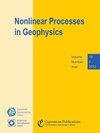利用矩阵剖面确定古气候时间序列中丹斯加德-奥斯赫格事件的特征
IF 2.4
4区 地球科学
Q3 GEOSCIENCES, MULTIDISCIPLINARY
引用次数: 0
摘要
摘要古气候时间序列反映了地球气候在遥远过去的状态,偶尔会出现非常大和快速的变化,证明了气候的突变性。在古气候记录中识别和描述这些突变特别令人感兴趣,因为这有助于了解千年气候变异性和识别当前气候变化背景下的潜在临界点。因此,能够在单个时间序列或两个代用记录中以客观和自动的方式描述这些事件特征的方法特别令人感兴趣。在我们的研究中,矩阵剖面方法被用于描述丹斯加德-奥斯赫格(Dansgaard-Oeschger,DO)事件、格陵兰冰芯中检测到的突然变暖以及北半球海洋和大陆记录。结果表明,发生在约 72 ka 和 76 ka 的典型事件 DO-19 和 DO-20 是过去 11 万年中最相似的事件。这些过渡的特点是与 DO-1、DO-8 和 DO-12 事件相对应的匹配过渡。这些转变非常突然,导致气候迅速变暖,随后又逐渐恢复到寒冷的气候条件。对 δ18O 和 Ca2+ 时间序列的联合分析表明,与 DO-19 事件相对应的过渡是两个时间序列中最相似的事件。本文章由计算机程序翻译,如有差异,请以英文原文为准。
Characterisation of Dansgaard-Oeschger events in palaeoclimate time series using the Matrix Profile
Abstract. Palaeoclimate time series, reflecting the state of Earth's climate in the distant past, display occasionally very large and rapid shifts, evidencing abrupt climate variability. The identification and characterisation of these abrupt transitions in palaeoclimate records is of particular interest as it allows the understanding of millennial climate variability and the identification of potential tipping points in the context of current climate change. Methods that are able to characterise these events in an objective and automatic way, in a single time series or across two proxy records, are therefore of particular interest. In our study the matrix profile approach is used to describe Dansgaard-Oeschger (DO) events, abrupt warmings detected in Greenland ice core, and Northern Hemisphere marine and continental records. The results indicate that canonical events DO-19 and DO-20, occurring at around 72 and 76 ka, are the most similar events over the past 110,000 years. These transitions are characterised by matching transitions corresponding to events DO-1, DO-8 and DO-12. These transitions are abrupt, resulting in a rapid shift to warmer conditions, followed by a gradual return to cold conditions. The joint analysis of the δ18O and Ca2+ time series indicates that the transition corresponding to the DO-19 event is the most similar event across the two time series.
求助全文
通过发布文献求助,成功后即可免费获取论文全文。
去求助
来源期刊

Nonlinear Processes in Geophysics
地学-地球化学与地球物理
CiteScore
4.00
自引率
0.00%
发文量
21
审稿时长
6-12 weeks
期刊介绍:
Nonlinear Processes in Geophysics (NPG) is an international, inter-/trans-disciplinary, non-profit journal devoted to breaking the deadlocks often faced by standard approaches in Earth and space sciences. It therefore solicits disruptive and innovative concepts and methodologies, as well as original applications of these to address the ubiquitous complexity in geoscience systems, and in interacting social and biological systems. Such systems are nonlinear, with responses strongly non-proportional to perturbations, and show an associated extreme variability across scales.
 求助内容:
求助内容: 应助结果提醒方式:
应助结果提醒方式:


